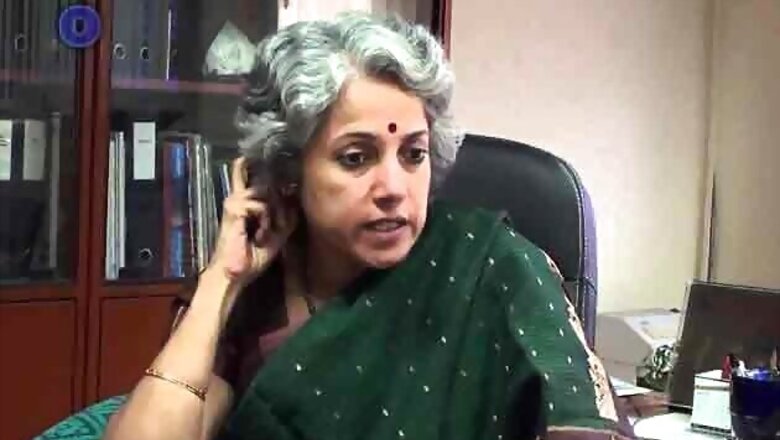
views
New Delhi/Chennai: Almost 2.3 million Tuberculosis cases are reported in India each year, one fourth of the global incidence. On March 24, the global community will be observing World TB Day. This presents an opportunity for us to talk about one of the most significant public health challenges in our country - TB. One of India's leading experts on TB Dr Soumya Swaminathan talks about the various facets of the disease, its causes, symptoms, prevention and control.
Brief profile: Dr Soumya Swaminathan, Director, National Institute for Research in Tuberculosis
Dr Swaminathan is the Director of the National Institute for Research in Tuberculosis. She is a pediatrician by training and has been involved in TB research for over 19 years. She has over 150 publications in peer-reviewed journals and 13 book chapters to her credit on various topics in the fields of pediatrics, tuberculosis, and HIV. She also provides ongoing research support to the National AIDS Control Program, the Department of Biotechnology, and the Indian Council of Medical Research (ICMR).
1. What is Tuberculosis (TB)? How does it spread? What conditions make people vulnerable to the spread of TB?
A: TB is a bacterial infection caused by a microbe called Mycobacterium tuberculosis. It is an airborne infection, which means that when a person infected with TB coughs or sneezes, the bacteria are released into the air and are suspended like dust particles, and another person breathing the same air can develop infection in their lungs. In most people the immune system is able to control and contain the infection. In a small proportion of people, (5-10%), a weak immune system lets the bacteria grow and multiply and causes what we know as tuberculosis disease. Overcrowding, poor ventilation, poor hygiene habits such as coughing or sneezing without covering the mouth are factors that aid the spread of TB. Of the other factors that help TB develop, malnutrition is the most significant as it compromises a person's immune system. An immune system weakened due to cancer, chemotherapy, long-term steroid usage or chronic diabetes also predisposes to TB infection.
2. How are nutrition and TB linked?
A: Nutrition and TB are linked very closely. Malnutrition or undernutrition causes weakening of a person's immune system, thus increasing their vulnerability to TB. Recent studies have shown that malnutrition is responsible for about 50% of all TB cases in India. TB and nutrition have a bidirectional relationship. Malnutrition increases the risk of TB, and the disease itself further reduces the nutritional status of the patient. If we do not improve the nutritional status of our population, we may not be able to control TB completely.
3. How is TB diagnosed? What is the most accurate and quickest way to diagnose TB?
A: The gold standard of TB diagnosis is to find the TB bacterium in sputum or tissue through smear microscopy, culture and now through newer molecular tests like GeneXpert. The most common form of TB is pulmonary (lung) TB, for which diagnosis is done by running these tests on a sputum/phlegm sample. X-rays, CT Scans as well as tissue biopsy also aid in the diagnosis of TB, which depends upon the organ infected by TB. There have been many advances in TB diagnostics in recent times, most notably rapid molecular tests. The GeneXpert test or CBNAAT is a WHO-approved diagnostic tool that is most in use worldwide. However, Indian companies are working on manufacturing similar molecular tests that can be made available at a lower cost.
4. What is drug-resistant TB and how does it develop?
A: Drug-resistant TB is the term used when the TB bacterium becomes resistant to one or more anti-TB medicines. Multi-drug resistant TB (MDR-TB) is defined by the resistance of the bacterium to Isoniazid and Rifampicin, the two most commonly-used and most powerful anti-TB drugs. (Extensively drug resistant TB) XDR TB is when the bacillus develops further resistance to an injectable second-line TB drug as well as a fluoroquinolone. The biggest problem caused by drug-resistant TB is that we lose the most powerful and safe drugs with which to treat the disease, and end up having to use a combination of drugs that are less effective and more toxic.
5. Are there vaccines available for TB? How effective have they proven to be?
A: The Bacillus Calmette-Guérin vaccine has been used for over a century to immunize children. It has been shown to be safe and efficacious in preventing severe forms of TB in children, which is why it is still in use. The vaccine's effect, however, wanes off after the first few years of life, providing no protection to adults. Unfortunately, we do not yet have a vaccine that provides longer protection against TB. There are clinical trials being conducted for a number of candidate vaccines, and we hope to have one in 5-10 years from now.
6. Why is private sector engagement important to reduce the burden of TB?
A: Half of all TB patients in India get treated in the private sector. Unless we ensure that these patients are treated and cured as per the same standards offered in the public sector, we will be unable to make a significant dent in the overall TB burden. This is where the private sector plays a critical role, and it is necessary to engage with them for a disease with such significant public health implementation.
7. How important is creating awareness and why?
A: Awareness about TB is probably the most important aspect, and has been neglected for far too long. Unless people are aware of the causes, symptoms and treatment of TB, they cannot avail of the services being offered for its prevention and control. We have seen in the case of HIV, that the massive awareness campaign really helped sensitize the community to reduce the spread of HIV. We must do the same for TB as we go forward.
8. What are the challenges going forward?
A: The challenges can be listed out in many ways. In India, the sheer numbers are large and the heterogeneity of our population poses a challenge. So you have to deal with TB in varied settings from the urban slums of Mumbai to the remote hills of Arunachal Pradesh. For overcoming this, we need decentralized planning because centralized planning can only work up to a certain level and beyond that, you need to plan according to your local environment.
Lack of awareness among the public about TB needs to be addressed through massive media campaigns.
The third challenge is we need to align what is happening in the private sector and the public sector. Both these sectors need to be involved in fighting TB and this needs to be done in a partnership mode rather than one sector dictating to the other one.
Political commitment from the highest level is needed. Once our top politicians speak up about TB and the fact that we need to address it, things will fall in place. In fact, our previous Health Minister, Dr. Harshvardhan, made a strong commitment at the Barcelona conference that India would try to achieve the goals set by the Stop TB Partnership and do faster than what was projected for the rest of the world. I think if we take that pledge seriously, we can indeed make India TB-free.



















Comments
0 comment